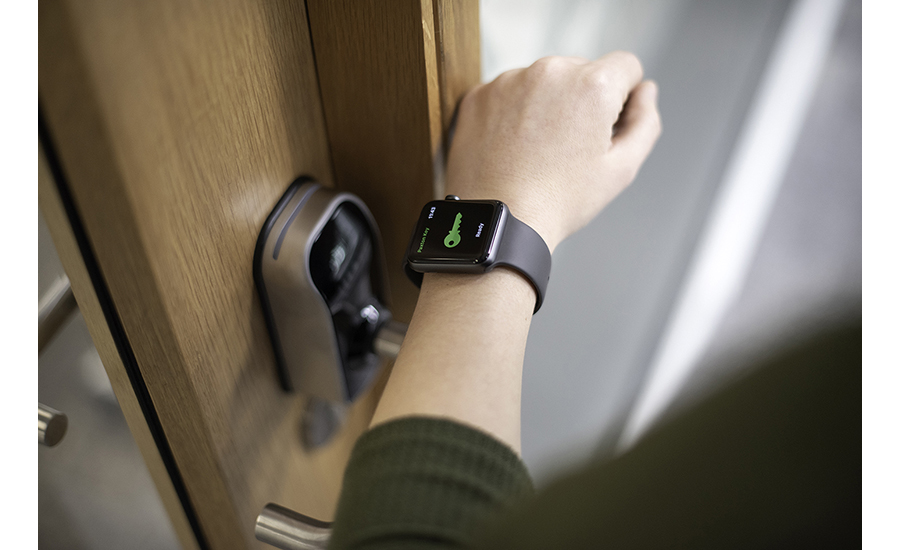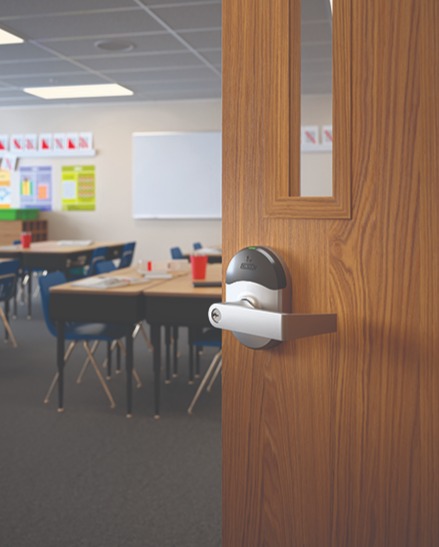How Wireless Access Is Transforming Security Deployments
Wireless access control solutions offer ease of installation, increased flexibility, scalability, and cost-effectiveness to end user installations.

One of the primary benefits of wireless electronic access control solutions is being able to install in previously difficult or even impossible locations. // IMAGE COURTESY OF ASSA ABLOY
On the right project, wireless access control solutions can offer ease of installation, increased flexibility, scalability and cost-effectiveness. They can also help security integrators to more easily add electronic access control on interior doors, cabinets or other areas that would be difficult and expensive to wire.
In some cases, these solutions can even offer recurring monthly revenue (RMR) opportunities such as remote system monitoring, software updates, troubleshooting and maintenance contracts to customers.
Ahead, experts weigh in on how that all translates to business opportunities.

Installation Advantages
Wiring access control into a building and almost all of the labor and planning associated with it can be bypassed with the implementation of wireless solutions. And these solutions can be installed in locations that previously may have been problematic — if not impossible — to consider.
“Oftentimes, integrators are unable to install access control in certain spaces due to construction constraints and areas that don’t allow for easy cable runs to the opening,” says Brach Bengtzen, vice president of marketing, PDK, Draper, Utah. “In order to provide access control in areas like this, it requires extensive drilling, conduit runs, and additional cabling that can drive costs to unaffordable rates.”
Bengtzen continues, “The ability to add a wireless door controller or lockset to a door means added savings for access control systems that can be passed on to the end user. In addition to less overhead on hardware, installations are often easier to perform, which reduces the amount of labor required to install access control on an opening.”
This means that security integrators can utilize the flexibility of wireless access control solutions to better meet end users’ specific needs.
“Wireless technology allows you to consider access control in locations where a typical wired solution would not be feasible,” says Steve Rowlands, divisional director of product management, Paxton Access, Greenville, S.C. “This may be a listed building where there are restrictions modifications to the building itself, or a location with insufficient cabling to support a hard-wired solution and no access to do so. Wireless offers installers a wider range of solutions to meet their customers’ needs as well as offering the end user a more cost-effective and simple solution.”
Lester LaPierre, ASSA ABLOY Opening Solutions, New Haven, Conn, says, “Wired solutions require multiple trades and six to eight hours of time to install a locking device — strike, maglock, electro-mechanical lock — plus a wall reader, sensors for door position and so forth, many of which require conduit. Today’s intelligent wireless and Wi-Fi solutions integrate these components into a single locking device, which means trained and certified integrators can have an opening installed and ready in about an hour.”
And LaPierre says that this can translate to more efficient use of an organization’s security budget. “The advantage of wireless is its affordability and lower total cost of ownership. The labor and time involved in installing a wireless electronic access control (EAC) lock is a fraction of what it would typically take for a wired opening. This gives systems integrator businesses the ability to magnify staff productivity and the number of access-controlled doors they can propose to customers for better use of their security budgets.
“Given how access control is becoming increasingly critical and desirable for interior spaces, integrators have the opportunity to help customers stretch their budgets dramatically to accommodate and support many more openings than previously possible,” LaPierre continues. “Listen to your clients’ needs opening by opening. What type of locking devices are in use? Are they mortise, cylindrical, RIM exit, FEMA rated, or a sampling of each? If a mix of lock types, does the system under consideration offer the required lock types. Do they need the ability to remotely lock and unlock them? If so, they are excellent candidates for real-time wireless access control. Will they always be locked? If so, they are a great candidate for more cost-effective Wi-Fi locks, as they utilize existing network infrastructure.”
Like any vertical, there are certain terms to familiarize yourself with. Bobby Welliver, assistant vice president of multi-family housing solutions, dormakaba, Indianapolis, Ind., points to a distinction between two different types of wireless offerings. “Selling more doors with wireless options starts with understanding the term and specific applications,” he says. “The term ‘wireless options’ includes both wireless online and battery-operated ‘standalone’ doors, both of which operate without wires; however, they have totally different uses:
- BATTERY-OPERATED WIRELESS (STANDALONE) LOCKS are often favored due to cost and ease of deployment. A property can take an existing door and make it wireless without having to add a network, hard wiring, etc. All that is typically required is to prep the door with whatever modifications may be needed to install the lock through the use of the proper door prep template for the specific locks being used. Retrofits often seek battery-operated wireless options because they involve fewer steps to install than with online wireless options and do not require network connections or hard-wired applications to work correctly.
- WIRELESS ONLINE is ideal for properties that need instant data at their fingertips such as audits, people flow, and visitor management, but this can also be accomplished through a hybrid approach that can blend battery operated standalone locks together with real-time hard wired networked solutions where needed.”
RMR Potential
The security industry — like most industries — is shifting to mirror the subscription model in response to the success of streaming services. End users — and the average consumer — currently seem to prefer that month-to-month relationship over the traditional one-and-done transaction. This opens up the opportunity for integrators to offer increased value for the end user in exchange for recurring monthly revenue (RMR).
“When these wireless solutions are integrated or used with a cloud based access control software, integrators are able to provide multiple benefits such as automatic updates, real-time status updates, remote troubleshooting and on-the-go management,” Bengtzen says. “Because of these benefits, integrators are able to generate additional recurring revenue, usually on a per door basis, for their business.”
La Pierre agrees, “Most integrators have historically been selling service contracts to cover monitoring, administration, and maintenance — depending on the customer’s needs. Some stipulate certain required response times to repair or reboot an opening that has gone offline. Depending on the location and critical importance of the door, that response might need to be as soon as an hour or can be as long as 24 hours.”

Additionally, this can also be a more efficient use of an organization’s security budget, allowing more doorways to be protected for less.
“Many of these contracts are based on the number of openings that are included,” LaPierre says. “Offering wireless digital access solutions increases the opportunity to secure more openings for a better value, which need to tie into existing major online EAC systems and — subsequently — be supported by comprehensive services like 24/7 monitoring and regular preventive maintenance. In addition, wireless openings come online much faster than traditional wired openings, so the RMR clock starts much sooner. Common preventive maintenance tasks may include annual battery replacement, and system and functional testing.”
And this has been enabled by advancements in cloud technology. “The cloud has been revolutionary in this industry,” Bengtzen says. “Integrators are able to provide multiple benefits to their end users such as automatic updates, real-time status updates, remote troubleshooting and on-the-go management. This helps integrators not only generate additional recurring revenue, but also helps provide more value. In addition, the cloud allows integrators to configure and program wireless controllers and locksets faster than ever by simply using a mobile app. There is no need to have an onsite computer or server anymore in order to get a system up and running. In the case where troubleshooting is ever needed, the cloud allows integrators to use their mobile app to view the status and check on the health of every lockset or controller that is on the system.”
David Ito, project manager, Camden Door Controls, Mississauga, Ontario, adds, “Cloud-based access control systems — combined with wireless access control solutions — offer integrators and end-users the flexibility to access and control their systems from anywhere with an internet connection. Furthermore, cloud-based platforms facilitate data analytics, reporting, and integration with other building management systems, enhancing overall efficiency and security.”
LaPierre concludes, “The cloud also provides system redundancy and backups, eliminating the need for an employee to manage those functions. Some integrators offer their own cloud server systems and manage sites for their customers, which creates another RMR stream.”
Even with all the benefits wireless can bring, it’s not common that in installation is only wireless. More often, experts explain, the security integrator is blending the world of wired and wireless solutions to tailor the perfect solution for end users. These hybrid options — a combination of both types of solution — can offer even greater flexibility, combining the best of both offerings.
“For new installations, being able to offer a hybrid wired and wireless solution allows the installer to tailor the system perfectly to the needs of the customer and offer them better value whilst securing more doors across the customer site,” says Steve Rowlands, Paxton Access. “We’re seeing a huge interest in hybrid approaches that can include a mix of standalone offline, wireless online, and hardwired access points all working together, through a single user interface.
This can be an approach for future-proofing installations. “Properties are trying to get to a point that allows for scalability now and in the future,” says Bobby Welliver, dormakaba. “They’re now opting for all three access solutions to allow flexibility for control, budget and technologies used, so they can deliver the right mix of benefits, capabilities, and control, property wide that enhance the overall user experience for everyone involved.
And David Ito, Camden Door Controls, says, “Furthermore, as the Internet of Things (IoT) continues to evolve, integrators can explore integrating wireless access control with other smart building systems for comprehensive solutions.”
Sectors Ripe for Wireless
Ito says the following sectors are ripe for wireless access control solutions: commercial buildings, healthcare facilities, educational institutions, government offices and residential complexes. Additionally, industries with dynamic access control needs, such as coworking spaces and hospitality, present lucrative opportunities.
LaPierre says, “Schools and classrooms are a prime example of how real-time wireless access control locksets are being applied. Higher education residence halls have shown how well Wi-Fi solutions are working as a convenient and lower-cost, ‘centrally-managed’ option both for retrofit projects and new construction.”

Bengtzen points to multi-dwelling units as another area of growth for the wireless access control vertical. “Multi-dwelling units has been one of the most popular verticals in access control as of late,” he says. “Hardwired perimeter access integrated with intercom systems, gates, management software, and wireless tenant locks has been very popular thanks to booming populations in nearly every market. Having integrated wireless locksets on every tenant door creates a great experience for the integrator, property manager, and tenant where one single credential can be used on perimeter access, common facilities such as fitness centers and pools, and even their own dwelling.”
Peter Toney, electronic sales engineer, Allegion, Carmel, Ind., says, “There are business opportunities with wireless everywhere. Just about in every building within every vertical market, there are business opportunities for a wireless solution. Think of the last building that you entered that didn’t have a mechanical lock on the front, back or side door — you can’t. Every door that is secured today with a mechanical lock and key is an opportunity."
Looking for a reprint of this article?
From high-res PDFs to custom plaques, order your copy today!







